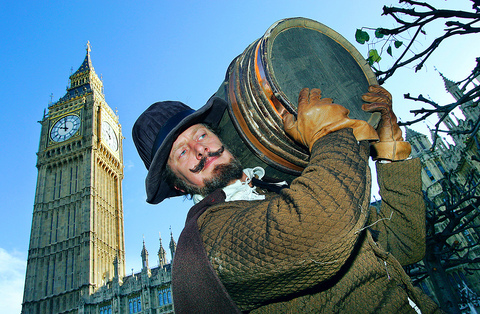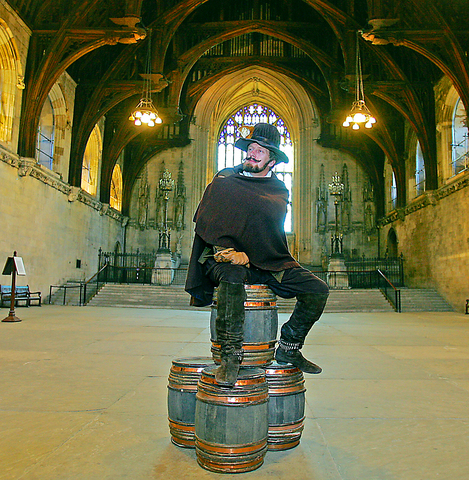Even by the standards of today's global terrorism, it was a bold and brazen act: sneaking 36 barrels of gunpowder under the Houses of Parliament and blowing England's power elite to smithereens.
Tonight, the night sky across Britain will be alive with bonfires and pyrotechnics for the 400th anniversary of the gunpowder plot -- an unofficial holiday better known as Bonfire Night or Guy Fawkes Day.
Comparisons with the July 7 attacks in London, in which 52 subway and bus commuters were killed by four apparent Islamist suicide bombers in the deadliest act of terrorism ever on British soil, may perhaps be inevitable.

PHOTOS: AFP
Enduring, however, will be the popular fascination with Fawkes and his co-conspirators, drawn from a then-repressed Catholic minority who apparently felt that the nation, by embracing Protestantism, was treading the wrong path.
More than 50,000 people have already visited a gunpowder plot exhibition since it opened in July in the Gothic parliament buildings on the banks of the River Thames -- ground zero for the blast that might have been.
"Obviously there is a resonance [to contemporary terrorism], but we'd rather like people to come to their own conclusions," said the exhibition's project manager David Prior.

Other commemorations are underway at the Tower of London, the National Portrait Gallery, the National Archives (where Fawkes' signed confession is on display) and the Shakespearean Globe theater.
In a turn unthinkable for the likes of Osama bin Laden or the Irish Republican Army, the Museum of London is holding a day-long study today titled: "Understanding Guy Fawkes."
In southeast England, meanwhile, huge crowds are once again expected in the sleepy town of Lewes, East Sussex for Britain's biggest Nov. 5 gathering, a night of bonfires, fireworks, effigies and residual anti-Papist motifs.
Exactly how the gunpowder plot was cooked up is a fact lost in the haze of time, according to a fact sheet helpfully provided by the House of Commons information office on its Web site (www.parliament.gov.uk).
"Generations of historians accepted it as a genuine last desperate attempt to re-establish the Catholic religion," although another theory is that the plotters were actually agents provocateur aiming to discredit Catholics and reinforce Protestantism, it said.
One way or another, Fawkes and his original gang of four co-conspirators -- the numbers grew in time, making it harder to keep secrecy -- decided in 1604 to blow up parliament on Nov. 5, 1605, the day of its state opening.
The king would be there, along with his heir apparent, and every member of the House of Commons and the House of Lords.
The 36 barrels of gunpowder, big and small, were smuggled into a coal room beneath the parliament leased by one of the conspirators, and the plan was for army veteran Fawkes to light the fuses and then skedaddle to mainland Europe.
The official version is that a Catholic peer got a timely tip off, prompting a midnight search in which Fawkes was cornered in the basement with his deadly pile of barrels hidden under black coal.
While all the conspirators were rounded up, Londoners rejoiced on the streets at the plot's failure.
The scene turned gruesome in subsequent months as Fawkes and his cohorts, in the fashion of the day, were tried, tortured, disemboweled alive, then hanged and quartered for treason.
Exactly how much destruction they would have wrought in the heart of London has been and remains today a topic of heated scholarly debate.
Researchers at the University of Wales reckoned two years ago that the blast would have devastated a 490m radius -- an area that would include today's Downing Street, Foreign Office and Ministry of Defense.
But an ambitious re-creation of the blast by ITV television, using sensors and crash-test dummies, suggested that the impact would have been relatively contained, though with debris raining over 200m.
"We concluded that he [Fawkes] could have killed everyone present with half the amount of explosive," added David Hadden, a blast consultant on The Gunpowder Plot: Exploding the Legend.
Historian Justin Pollard told the program: "The whole plot was massively ill-conceived."
"They seemed to think they could change the politics of the whole country by blowing up a few hundred people."
"In reality, the blast would have sent shockwaves through the Protestant community, bolstering their resolve against the hugely outnumbered Catholics and sparking ruthless revenge."

This is the year that the demographic crisis will begin to impact people’s lives. This will create pressures on treatment and hiring of foreigners. Regardless of whatever technological breakthroughs happen, the real value will come from digesting and productively applying existing technologies in new and creative ways. INTRODUCING BASIC SERVICES BREAKDOWNS At some point soon, we will begin to witness a breakdown in basic services. Initially, it will be limited and sporadic, but the frequency and newsworthiness of the incidents will only continue to accelerate dramatically in the coming years. Here in central Taiwan, many basic services are severely understaffed, and

Jan. 5 to Jan. 11 Of the more than 3,000km of sugar railway that once criss-crossed central and southern Taiwan, just 16.1km remain in operation today. By the time Dafydd Fell began photographing the network in earnest in 1994, it was already well past its heyday. The system had been significantly cut back, leaving behind abandoned stations, rusting rolling stock and crumbling facilities. This reduction continued during the five years of his documentation, adding urgency to his task. As passenger services had already ceased by then, Fell had to wait for the sugarcane harvest season each year, which typically ran from

It is a soulful folk song, filled with feeling and history: A love-stricken young man tells God about his hopes and dreams of happiness. Generations of Uighurs, the Turkic ethnic minority in China’s Xinjiang region, have played it at parties and weddings. But today, if they download it, play it or share it online, they risk ending up in prison. Besh pede, a popular Uighur folk ballad, is among dozens of Uighur-language songs that have been deemed “problematic” by Xinjiang authorities, according to a recording of a meeting held by police and other local officials in the historic city of Kashgar in

It’s a good thing that 2025 is over. Yes, I fully expect we will look back on the year with nostalgia, once we have experienced this year and 2027. Traditionally at New Years much discourse is devoted to discussing what happened the previous year. Let’s have a look at what didn’t happen. Many bad things did not happen. The People’s Republic of China (PRC) did not attack Taiwan. We didn’t have a massive, destructive earthquake or drought. We didn’t have a major human pandemic. No widespread unemployment or other destructive social events. Nothing serious was done about Taiwan’s swelling birth rate catastrophe.